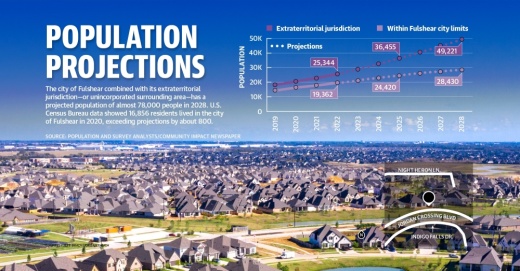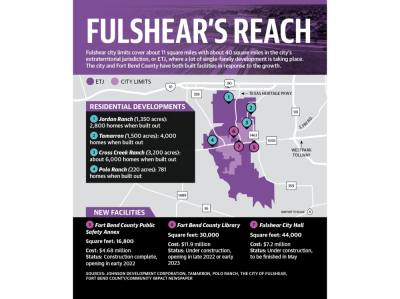According to spring 2020 projections by demographic firm Population and Survey Analysts, the Fulshear area’s population is expected to more than double between 2019 and 2028—jumping from 31,861 residents in the city and its extraterritorial jurisdiction, or ETJ, to 77,651 residents in 2028.
The city of Fulshear covers more than 11 square miles, but its ETJ—or the unincorporated area where Fulshear extends its legal power beyond city lines—includes about 40 square miles. Cities regulate their ETJs to prepare for the area’s eventual planned annexation, according to the Texas Public Policy Foundation, a nonprofit,
nonpartisan research institute.
PASA predicts Fulshear will gain about 1,640 residents per year, on average, for the decade following 2019. Comparably, its ETJ will gain about 3,321 residents per year, on average, during that same time.
Herman Rodriguez, Fulshear’s director of economic development, said the city of Fulshear has the fastest residential growth in the Houston area. He said the city’s location also offers economic support, driving growth.
“Fulshear nestles itself around the strong microeconomies of western Fort Bend County,” he said. “These solidify an economical force that craves suburban amenity-driven lifestyles.”
Fulshear Mayor Aaron Groff predicted the biggest hurdle will be managing expectations while balancing rapid residential growth with Fulshear’s small-town charm and increasing infrastructure needs.
“[The biggest hurdle is] always going to be managing that growth,” Groff said. “It’s a balancing act between property owner’s rights and people’s flood [and] drainage concerns. I think the biggest ... [challenge] is just managing expectations as we continue to build.”
Community development
According to city documents, 89% of land within Fulshear city limits is zoned residential. Many local businesses were drawn to master-planned communities built in the last 20 years, Johnson Development Corp. officials said. Recent master-planned developments include Tamarron, Fulbrook, Polo Ranch and Fulbrook at Fulshear Creek with Johnson Development Corp. building Jordan Ranch and Cross Creek Ranch.
Cross Creek Ranch, which broke ground in 2006, is located in city limits near the intersection of FM 1094 and FM 1463. As of December, the 3,200-acre community housed 4,600 families, development officials said.
Jordan Ranch, located south of the Katy Freeway and west of FM 1463 in Fulshear’s ETJ, increased its homesites by nearly 40% with the addition of 415 properties in fall 2021.
The school districts, Lamar CISD and Katy ISD, have also seen growth.
PASA projected KISD’s enrollment to reach 100,000 students by 2027—making it Texas’ fastest-growing large school district, said KISD officials. LCISD, which serves most of the ETJ, is especially influenced by the growth.
“It’s growing fast.... Even I’ve moved to Fulshear,” LCISD Superintendent Roosevelt Nivens said. “We have several more [campuses] that will be out in that area that [will] help with growth.”
As the district plans for the growth, developers are planning their build-out. Officials said Cross Creek Ranch will have 6,000 homes upon build-out, and Rob Bamford, general manager for Cross Creek Ranch, said the market will drive the build-out timeline. He said he expects it will be built out in the next three or four years.
Jordan Ranch General Manager Steve Sams said the city’s location near the Energy Corridor and the Houston metropolitan area is driving some of its popularity. The 1,350-acre development will ultimately house 2,800 families and sold its 1,000th homesite in December.
“[Fulshear] gives you a sense of being out in the open in the country, but you are still so close,” he said. “You can get to all those areas so quickly, especially with all the infrastructure that is popping up to serve all of these new communities.”
Balancing growth
Many recent infrastructure additions in the area aim to increase mobility to keep up with growth, such as Texas Heritage Parkway, a 5.9-mile project connecting the Katy Freeway to FM 1093 that was completed in August. The $55 million project was funded by Fort Bend County, the city of Fulshear, the city of Katy and private developers.
Officials are also working to increase mobility near the Westpark Tollway, adding westbound and eastbound connector roads from the Westpark Tollway to the Grand Parkway’s northbound roads. The $53.8 million county-funded project began last fall and is expected to be completed in 2024, according to county officials.
“With the newly opened [Texas] Heritage Parkway that runs between Westpark [Tollway] and I-10, ... that has really improved the mobility in and around our little submarket dramatically,” Bamford said. “We’ve been reframed, so to speak.”
To keep up with the population increases, the city of Fulshear and Fort Bend County have built new facilities in the Fulshear area. Fulshear is building a new 44,000-square-foot City Hall •near Cross Creek Ranch and the Marcel Town Center, which is expected to finish in May. The $7.2 million project is funded by the city.
Meanwhile, Fort Bend County built and funded a $4.68 million Public Safety Annex located off FM 1093, set to open early 2022. The county is also funding the construction of a $11.99 million library near Fulshear High• School, opening in late 2022 or early 2023, according to county officials.
“City Hall was definitely a response to growth,” Groff said. “[The facility] will meet the city’s needs for the next 15 years and will house the police department and all city services.”
Groff said while not all residents support the growth, development is inevitable, and infrastructure is needed to support it.
“People say they move here to live in a country town but then want to change it so it isn’t a country town anymore,” said Terry Nestor, a Fulshear resident of 28 years. “I miss being able to drive my tractor to the gas station without fear of getting run over. ... I’m glad I raised my kid in the ‘old Fulshear.’ It was a great little town. Now it’s just a suburb.”
Sams, too, said he understands why not all Fulshear residents are excited about their town changing.
“To be perfectly honest, I grew up on a ranch, and if I had 1,000 homes built next to me, I probably wouldn’t have been thrilled at the time either,” Sams said. “But Fulshear does have zoning in place to help protect those folks that were there first, which I think is good.”
Some Fulshear residents, however, support preparing for the growth.
Fulshear resident Joan Berger said community involvement can influence the changes.
“Fulshear does have a terrific plan, developed by residents, business owners and city staff,” Berger said. “Sticking to the plan is difficult but doable. ... [Residents should] send suggestions to the city, participate in the change, make it better. It’s going to change, so get involved.”
Fulshear’s future
According to Groff, the city has a myriad of processes to keep growth intentional, such as devel•oper agreements, a master mobility plan, an economic development strategy and a master trails plan.
“It’s all part of that planning process,” he said. “As we prepare for the growth through those developer agreements, through the plans, the studies that are in place, the city did a lot to make sure we have all the tools. Now, it is implementing those tools.”
Part of that vision will be maintained through the economic development strategy, which was developed in 2019.
The document said the city was at “a critical point in its growth trajectory where [undeveloped land] offers opportunities to influence its path forward in the face of strong market forces that are heavily weighted toward residential development.”
To ensure that trajectory aligns with the city’s needs, the document outlines three guiding principles around its economic development: excellent quality of place, fiscal sustainability and a balanced tax base. With these guidelines in mind, the city will move toward its goals of encouraging business development, making strategic investments and working on transformative projects, as well as promoting alignment within those goals.
According to the city, Fulshear will encourage business development by supporting tax base diversification, developing economic tools, managing projects, recruiting businesses, creating a business support network and following local business’ progress.
The city’s strategic investment goal will be met through encouraging development of “opportunity areas,” or areas that offer high commercial or catalytic potential; as well as identifying and prioritizing infrastructure projects; securing strategic land; and supporting projects that promote the city’s economic development vision, the documents said.
Lastly, the documents said the city’s goal of promoting transformative projects will be reached through preserving and enhancing Fulshear’s character and quality through catalytic projects, such as a downtown and a lifestyle center, as well as creating a structure for finding and prioritizing future projects.
Groff also said the city is working with developers to manage growth while respecting residents, including by minimizing the density of new construction and emphasizing larger lots.
“I would say to anybody [who does not want the growth]: Look, we understand you want to maintain that small-town charm and who Fulshear is, so we are working really hard to make sure that we have that and we can manage that growth in a way that satisfies long-term residents,” he said.
While Fulshear’s future is still largely unknown, developers and city officials agree: The growth is not stopping. Eventually, the city could annex Jordan Ranch and other communities into city limits, Groff said.
“Most of that ETJ mass will be brought into the city,” Groff said. “We are cognizant of that when we work with the developers and come to an agreement as to what annexation will look like. ... We start that conversation from Day One.”
As for annexation, it will not be happening any time soon.
“Truth be told, those are 25-30 years down the road,” Groff said.
As Fulshear eyes its upcoming 200th birthday, Rodriguez said a city’s future is just as important as its past.
“Fulshear has been around for generations,” he said. “It is all about knowing its history and honoring it, but we also know that Fulshear has a bright future, and we need to leave a legacy for the generations to come.”






